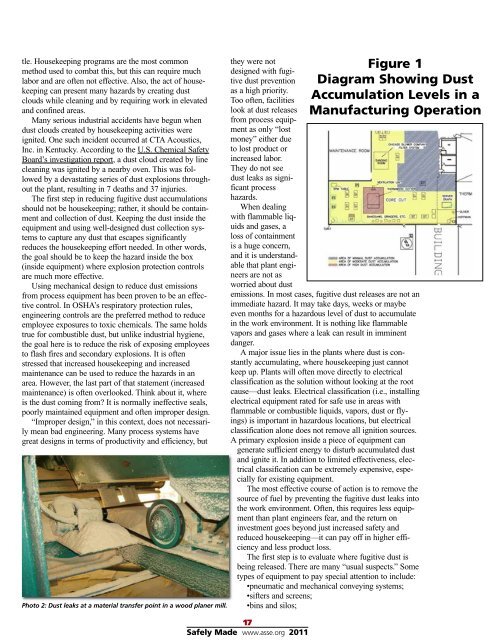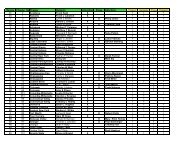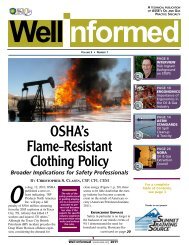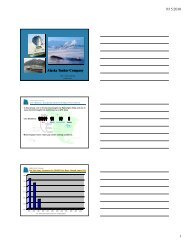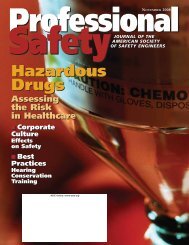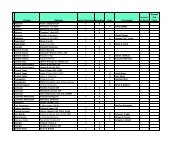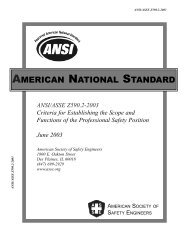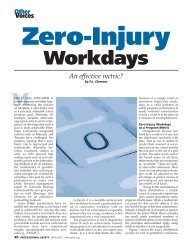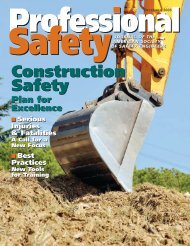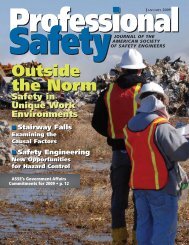Safety & Health Effects of Shift Work - ASSE Members
Safety & Health Effects of Shift Work - ASSE Members
Safety & Health Effects of Shift Work - ASSE Members
You also want an ePaper? Increase the reach of your titles
YUMPU automatically turns print PDFs into web optimized ePapers that Google loves.
tle. Housekeeping programs are the most common<br />
method used to combat this, but this can require much<br />
labor and are <strong>of</strong>ten not effective. Also, the act <strong>of</strong> housekeeping<br />
can present many hazards by creating dust<br />
clouds while cleaning and by requiring work in elevated<br />
and confined areas.<br />
Many serious industrial accidents have begun when<br />
dust clouds created by housekeeping activities were<br />
ignited. One such incident occurred at CTA Acoustics,<br />
Inc. in Kentucky. According to the U.S. Chemical <strong>Safety</strong><br />
Board’s investigation report, a dust cloud created by line<br />
cleaning was ignited by a nearby oven. This was followed<br />
by a devastating series <strong>of</strong> dust explosions throughout<br />
the plant, resulting in 7 deaths and 37 injuries.<br />
The first step in reducing fugitive dust accumulations<br />
should not be housekeeping; rather, it should be containment<br />
and collection <strong>of</strong> dust. Keeping the dust inside the<br />
equipment and using well-designed dust collection systems<br />
to capture any dust that escapes significantly<br />
reduces the housekeeping effort needed. In other words,<br />
the goal should be to keep the hazard inside the box<br />
(inside equipment) where explosion protection controls<br />
are much more effective.<br />
Using mechanical design to reduce dust emissions<br />
from process equipment has been proven to be an effective<br />
control. In OSHA’s respiratory protection rules,<br />
engineering controls are the preferred method to reduce<br />
employee exposures to toxic chemicals. The same holds<br />
true for combustible dust, but unlike industrial hygiene,<br />
the goal here is to reduce the risk <strong>of</strong> exposing employees<br />
to flash fires and secondary explosions. It is <strong>of</strong>ten<br />
stressed that increased housekeeping and increased<br />
maintenance can be used to reduce the hazards in an<br />
area. However, the last part <strong>of</strong> that statement (increased<br />
maintenance) is <strong>of</strong>ten overlooked. Think about it, where<br />
is the dust coming from It is normally ineffective seals,<br />
poorly maintained equipment and <strong>of</strong>ten improper design.<br />
“Improper design,” in this context, does not necessarily<br />
mean bad engineering. Many process systems have<br />
great designs in terms <strong>of</strong> productivity and efficiency, but<br />
Photo 2: Dust leaks at a material transfer point in a wood planer mill.<br />
they were not<br />
designed with fugitive<br />
dust prevention<br />
as a high priority.<br />
Too <strong>of</strong>ten, facilities<br />
look at dust releases<br />
from process equipment<br />
as only “lost<br />
money” either due<br />
to lost product or<br />
increased labor.<br />
They do not see<br />
dust leaks as significant<br />
process<br />
hazards.<br />
When dealing<br />
with flammable liquids<br />
and gases, a<br />
loss <strong>of</strong> containment<br />
is a huge concern,<br />
and it is understandable<br />
that plant engineers<br />
are not as<br />
worried about dust<br />
emissions. In most cases, fugitive dust releases are not an<br />
immediate hazard. It may take days, weeks or maybe<br />
even months for a hazardous level <strong>of</strong> dust to accumulate<br />
in the work environment. It is nothing like flammable<br />
vapors and gases where a leak can result in imminent<br />
danger.<br />
A major issue lies in the plants where dust is constantly<br />
accumulating, where housekeeping just cannot<br />
keep up. Plants will <strong>of</strong>ten move directly to electrical<br />
classification as the solution without looking at the root<br />
cause—dust leaks. Electrical classification (i.e., installing<br />
electrical equipment rated for safe use in areas with<br />
flammable or combustible liquids, vapors, dust or flyings)<br />
is important in hazardous locations, but electrical<br />
classification alone does not remove all ignition sources.<br />
A primary explosion inside a piece <strong>of</strong> equipment can<br />
generate sufficient energy to disturb accumulated dust<br />
and ignite it. In addition to limited effectiveness, electrical<br />
classification can be extremely expensive, especially<br />
for existing equipment.<br />
The most effective course <strong>of</strong> action is to remove the<br />
source <strong>of</strong> fuel by preventing the fugitive dust leaks into<br />
the work environment. Often, this requires less equipment<br />
than plant engineers fear, and the return on<br />
investment goes beyond just increased safety and<br />
reduced housekeeping—it can pay <strong>of</strong>f in higher efficiency<br />
and less product loss.<br />
The first step is to evaluate where fugitive dust is<br />
being released. There are many “usual suspects.” Some<br />
types <strong>of</strong> equipment to pay special attention to include:<br />
•pneumatic and mechanical conveying systems;<br />
•sifters and screens;<br />
•bins and silos;<br />
17<br />
Safely Made www.asse.org 2011<br />
Figure 1<br />
Diagram Showing Dust<br />
Accumulation Levels in a<br />
Manufacturing Operation


